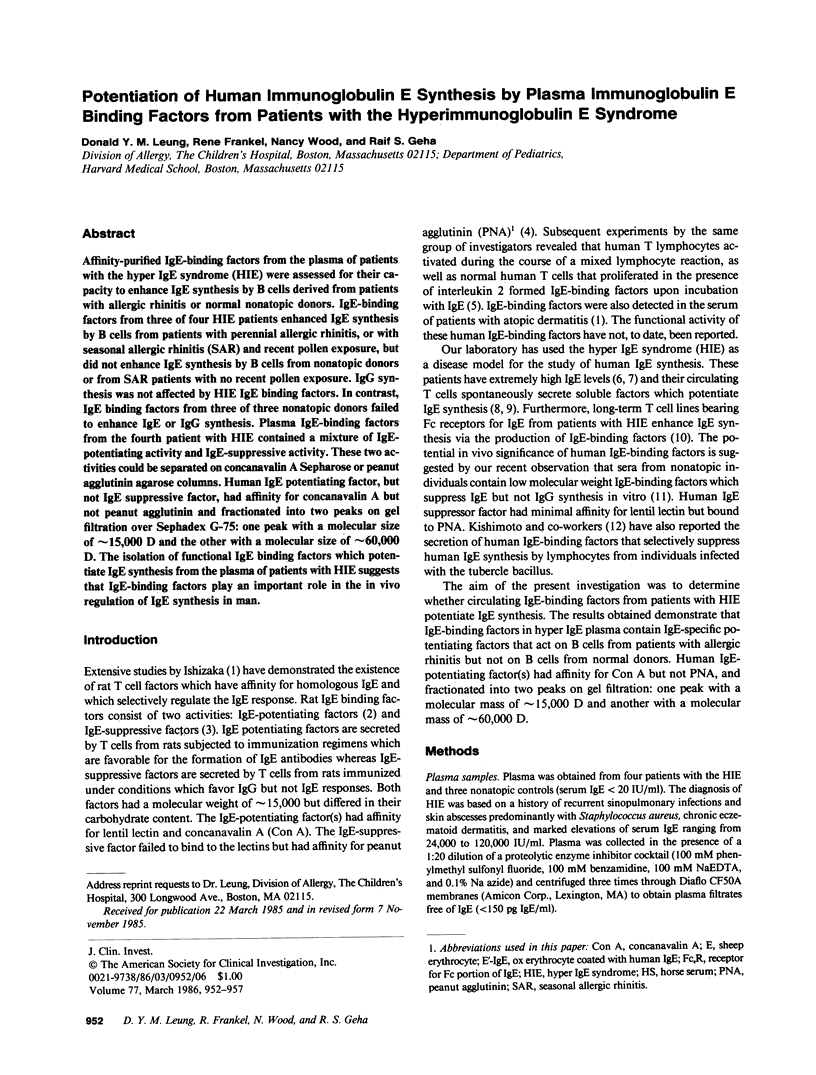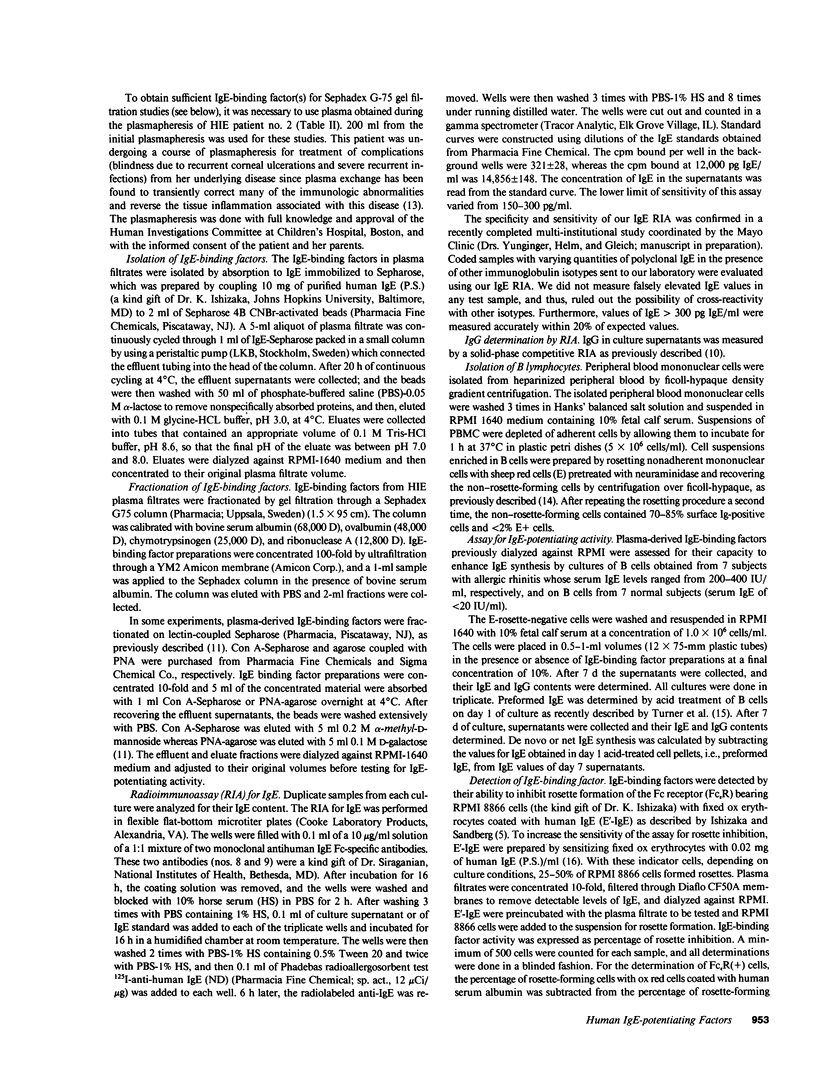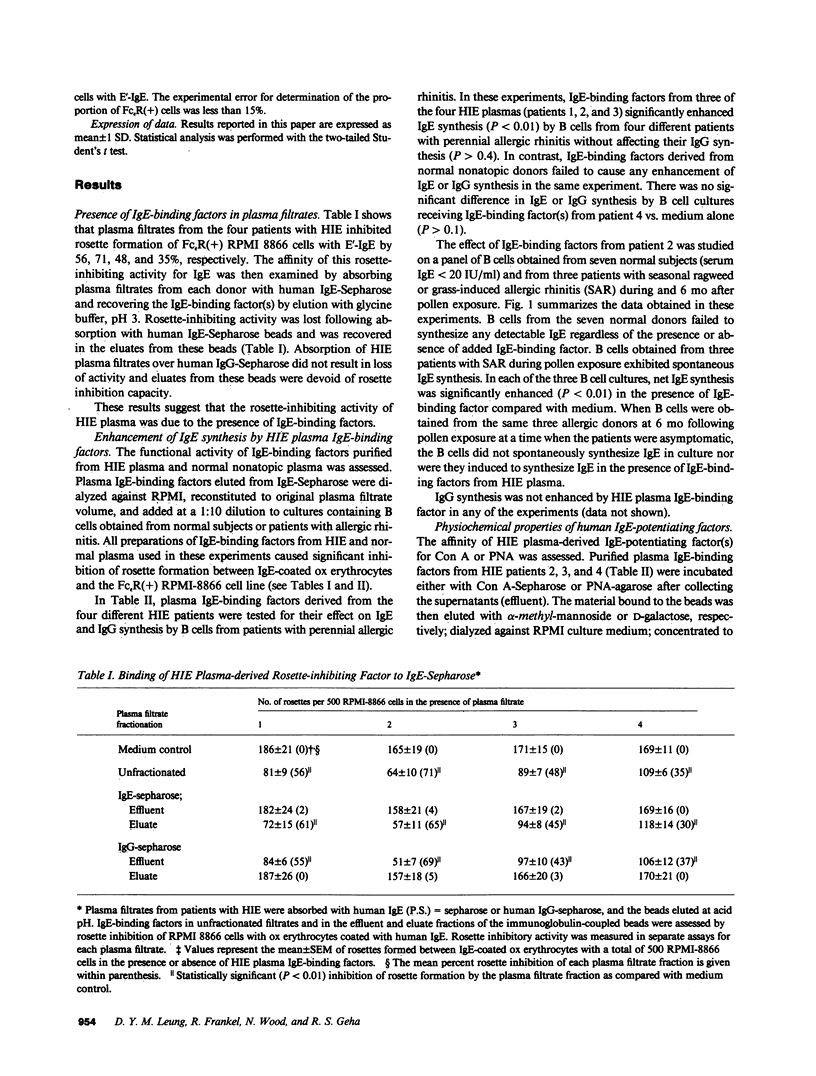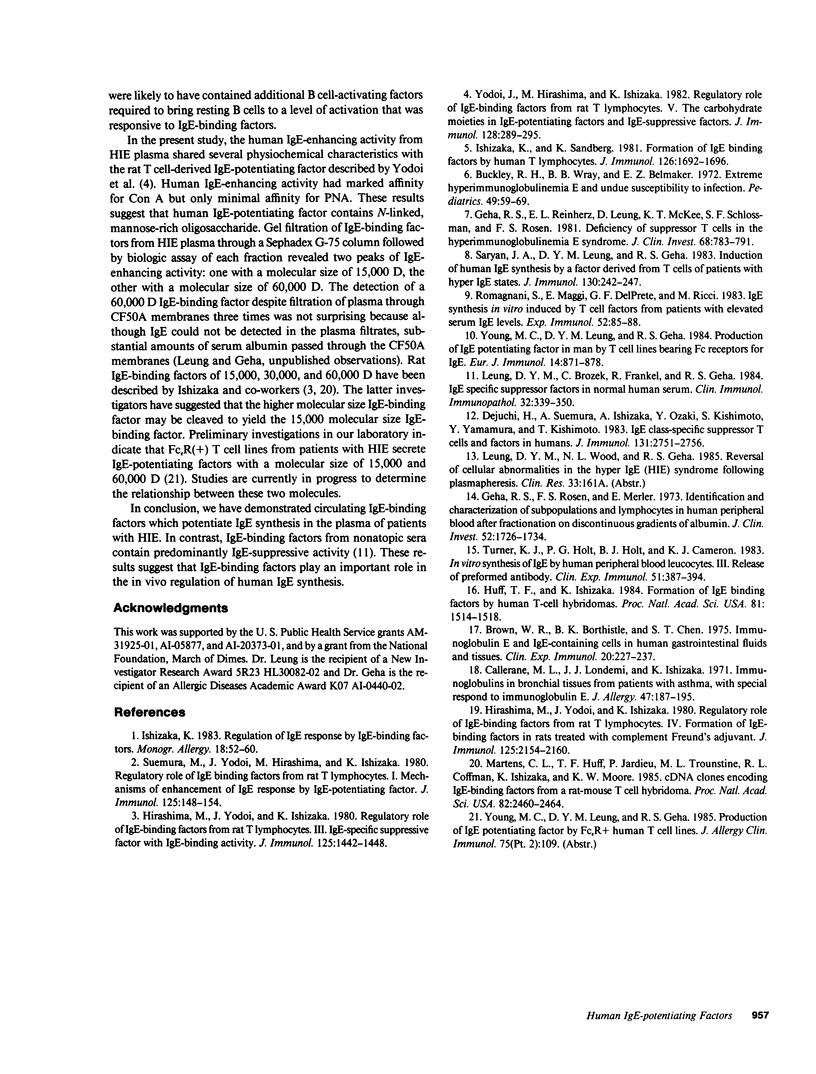Abstract
Affinity-purified IgE-binding factors from the plasma of patients with the hyper IgE syndrome (HIE) were assessed for their capacity to enhance IgE synthesis by B cells derived from patients with allergic rhinitis or normal nonatopic donors. IgE-binding factors from three of four HIE patients enhanced IgE synthesis by B cells from patients with perennial allergic rhinitis, or with seasonal allergic rhinitis (SAR) and recent pollen exposure, but did not enhance IgE synthesis by B cells from nonatopic donors or from SAR patients with no recent pollen exposure. IgG synthesis was not affected by HIE IgE binding factors. In contrast, IgE binding factors from three of three nonatopic donors failed to enhance IgE or IgG synthesis. Plasma IgE-binding factors from the fourth patient with HIE contained a mixture of IgE-potentiating activity and IgE-suppressive activity. These two activities could be separated on concanavalin A Sepharose or peanut agglutinin agarose columns. Human IgE potentiating factor, but not IgE suppressive factor, had affinity for concanavalin A but not peanut agglutinin and fractionated into two peaks on gel filtration over Sephadex G-75: one peak with a molecular size of approximately 15,000 D and the other with a molecular size of approximately 60,000 D. The isolation of functional IgE binding factors which potentiate IgE synthesis from the plasma of patients with HIE suggests that IgE-binding factors play an important role in the in vivo regulation of IgE synthesis in man.
Full text
PDF





Selected References
These references are in PubMed. This may not be the complete list of references from this article.
- Brown W. R., Borthistle B. K., Chen S. T. Immunoglobulin E (IgE) and IgE-containing cells in human gastrointestinal fluids and tissues. Clin Exp Immunol. 1975 May;20(2):227–237. [PMC free article] [PubMed] [Google Scholar]
- Buckley R. H., Wray B. B., Belmaker E. Z. Extreme hyperimmunoglobulinemia E and undue susceptibility to infection. Pediatrics. 1972 Jan;49(1):59–70. [PubMed] [Google Scholar]
- Deguchi H., Suemura M., Ishizaka A., Ozaki Y., Kishimoto S., Yamamura Y., Kishimoto T. IgE class-specific suppressor T cells and factors in humans. J Immunol. 1983 Dec;131(6):2751–2756. [PubMed] [Google Scholar]
- Geha R. S., Reinherz E., Leung D., McKee K. T., Jr, Schlossman S., Rosen F. S. Deficiency of suppressor T cells in the hyperimmunoglobulin E syndrome. J Clin Invest. 1981 Sep;68(3):783–791. doi: 10.1172/JCI110315. [DOI] [PMC free article] [PubMed] [Google Scholar]
- Geha R. S., Rosen F. S., Merler E. Identification and characterization of subpopulations of lymphocytes in human peripheral blood after fractionation on discontinuous gradients of albumin. The cellular defect in X-linked agammaglobulinemia. J Clin Invest. 1973 Jul;52(7):1726–1734. doi: 10.1172/JCI107354. [DOI] [PMC free article] [PubMed] [Google Scholar]
- Hirashima M., Yodoi J., Ishizaka K. Regulatory role of IgE-binding factors from rat T lymphocytes. III. IgE-specific suppressive factor with IgE-binding activity. J Immunol. 1980 Oct;125(4):1442–1448. [PubMed] [Google Scholar]
- Hirashima M., Yodoi J., Ishizaka K. Regulatory role of IgE-binding factors from rat T lymphocytes. IV. Formation of IgE-binding factors in rats treated with complete Freund's adjuvant. J Immunol. 1980 Nov;125(5):2154–2160. [PubMed] [Google Scholar]
- Huff T. F., Ishizaka K. Formation of IgE-binding factors by human T-cell hybridomas. Proc Natl Acad Sci U S A. 1984 Mar;81(5):1514–1518. doi: 10.1073/pnas.81.5.1514. [DOI] [PMC free article] [PubMed] [Google Scholar]
- Ishizaka K. Regulation of IgE response by IgE-binding factors. Monogr Allergy. 1983;18:52–60. [PubMed] [Google Scholar]
- Ishizaka K., Sandberg K. Formation of IgE binding factors by human T lymphocytes. J Immunol. 1981 May;126(5):1692–1696. [PubMed] [Google Scholar]
- Leung D. Y., Brozek C., Frankel R., Geha R. S. IgE-specific suppressor factors in normal human serum. Clin Immunol Immunopathol. 1984 Sep;32(3):339–350. doi: 10.1016/0090-1229(84)90277-0. [DOI] [PubMed] [Google Scholar]
- Martens C. L., Huff T. F., Jardieu P., Trounstine M. L., Coffman R. L., Ishizaka K., Moore K. W. cDNA clones encoding IgE-binding factors from a rat-mouse T-cell hybridoma. Proc Natl Acad Sci U S A. 1985 Apr;82(8):2460–2464. doi: 10.1073/pnas.82.8.2460. [DOI] [PMC free article] [PubMed] [Google Scholar]
- Saryan J. A., Leung D. Y., Geha R. S. Induction of human IgE synthesis by a factor derived from T cells of patients with hyper-IgE states. J Immunol. 1983 Jan;130(1):242–247. [PubMed] [Google Scholar]
- Suemura M., Yodoi J., Hirashima M., Ishizaka K. Regulatory role of IgE-binding factors from rat T lymphocytes. I. Mechanism of enhancement of IgE response by IgE-potentiating factor. J Immunol. 1980 Jul;125(1):148–154. [PubMed] [Google Scholar]
- Turner K. J., Holt P. G., Holt B. J., Cameron K. J. In vitro synthesis of IgE by human peripheral blood leucocytes. III. Release of pre-formed antibody. Clin Exp Immunol. 1983 Feb;51(2):387–394. [PMC free article] [PubMed] [Google Scholar]
- Yodoi J., Hirashima M., Ishizaka K. Regulatory role of IgE-binding factors from rat T lymphocytes. V. The carbohydrate moieties in IgE-potentiating factors and IgE-suppressive factors. J Immunol. 1982 Jan;128(1):289–295. [PubMed] [Google Scholar]
- Young M. C., Leung D. Y., Geha R. S. Production of IgE-potentiating factor in man by T cell lines bearing Fc receptors for IgE. Eur J Immunol. 1984 Oct;14(10):871–878. doi: 10.1002/eji.1830141003. [DOI] [PubMed] [Google Scholar]


